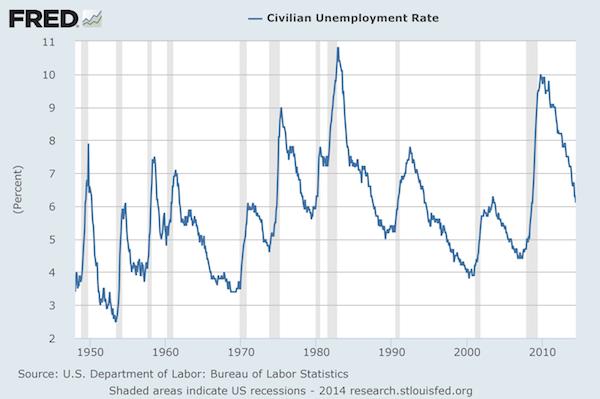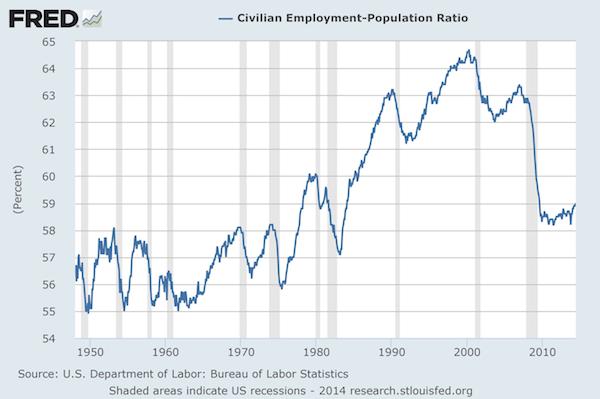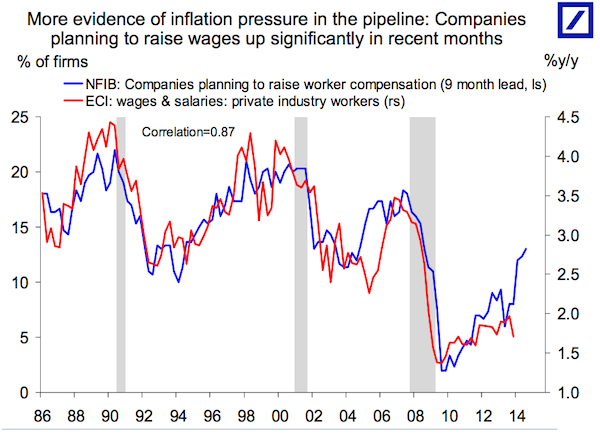As proprietors of a site which has continually highlighted that much of the recent unemployment rate reduction came from a reduction in the number of people working - and that weakness was reflected through the unemployment population ratio. A number of recent data points, however, suggest that the thaw is finally on - let's look at the signs that the job market is finally heating up!
Unemployment and the Civilian Employment Population Ratio
First up, of course, is the official U-3 unemployment ratio: roughly, the actual number of people who are in the labor force, but are not working at all. The most recent reading for unemployment, for June, came in at 6.1%. We hadn't seen 6.1% since August and September of 2008:
But just getting back to the peak of last recession's unemployment (6.3%, June 2003) isn't the hidden news. It's the fact that the unemployment reduction didn't come on the back of a reduction in labor force - as in, discouraged unemployed people didn't drop out at the rates we've seen in the past. Here's a glimpse at the most recent Civilian employment to population ratio, which recently ticked back up to 59%:
This is a good sign, especially when you combine it with the next section.
A Little Bit of Inflation
We recently highlighted that inflation, too, had ticked up to a 'more reasonable' level. Now, that might seem a curious comment... but a little bit of inflation is easier to deal with on a macroeconomic level. Most economic models have a zero rate bound, including monetary policy in general - although, of course, countries have taken some clever strides to get around that absolute. Suffice to say that even though deflation is obviously a workable model in tech fields, the wider economy functions better with just a little bit of inflation. Note our daily-updating inflation calculator here.
However, as the Carter-era 1970s taught us, inflation on its own isn't a reasonable policy goal, since it can come with increased unemployment and all that other malaise (see 'The Misery Index'). So, here's a WSJ link to a more specific line item (one that is tough to track because it reflects 'plans to increase'), wage pressures. Deutsche Bank put together the bull case on wage pressure in a recent research report:
That's the natural flow of things - once the employment market heats up (to abuse the heat jokes even further), so too do wage pressures - with all of the implications for inflation that implies. Basically, this is a more esoteric stat to follow, though - you need to rely on surveys and statistics like the labor market 'quit rate' (in stronger employment markets, it would make sense for more people to quit than be laid off).
What Else Are You Seeing?
Positive signs, finally, to be sure - we're optimistic that we've finally turned the corner. Yes, negative signs abound - including the -2.9% growth in GDP in the first quarter (which is near the top of readings not recorded in a recession) which we'll be closely watching. But - it all starts with employment. If we can see further employment gains, you'll hopefully see that GDP reading turn positive.
So, is the job market heating up? Is this a temporary positive blip of four indicators? What's your prediction for 2014 Q2 GDP? Let's hear it in the comments!



